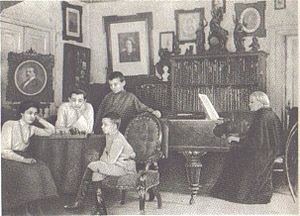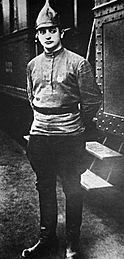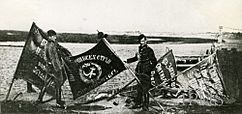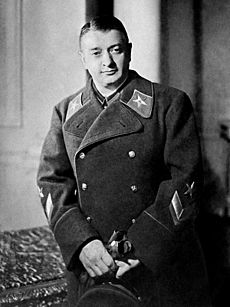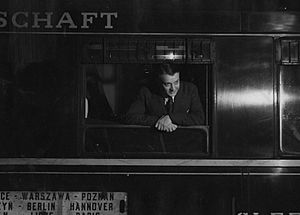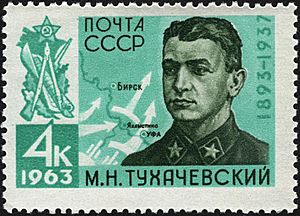Mikhail Tukhachevsky facts for kids
Quick facts for kids
Mikhail Tukhachevsky
Михаил Тухачевский |
|
|---|---|
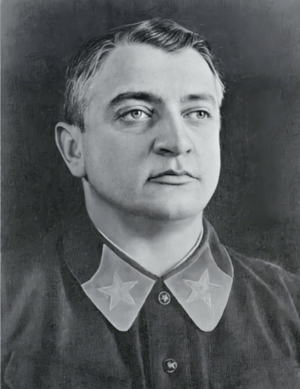
Tukhachevsky in 1935
|
|
| Birth name | Mikhail Nikolayevich Tukhachevsky Михаил Николаевич Тухачевский |
| Nickname(s) | Red Napoleon |
| Born | 16 February 1893 Alexandrovskoye, Dorogobuzhsky Uyezd, Smolensk Governorate, Russian Empire |
| Died | 12 June 1937 (aged 44) Moscow, Russian SFSR, Soviet Union |
| Buried |
Donskoye Cemetery
|
| Allegiance | |
| Service/ |
Imperial Russian Army Red Army |
| Years of service | 1914–1937 |
| Rank | Second Lieutenant Marshal of the Soviet Union |
| Commands held | Chief of General Staff |
| Battles/wars | First World War Russian Civil War Polish-Soviet War |
Mikhail Nikolayevich Tukhachevsky (Russian: Михаил Николаевич Тухачевский; February 16, 1893 – June 12, 1937) was a famous Soviet general. People sometimes called him the Red Napoleon. He was important in the Soviet military from 1918 to 1937.
He fought in World War I and the Russian Civil War. He helped defend Moscow and led armies on the Eastern Front of the Russian Civil War. He also helped take back Siberia and fought against other forces.
From 1920 to 1921, he led Soviet forces in the Polish–Soviet War. His armies pushed back Polish forces but were defeated near Warsaw. This war ended with the Peace of Riga.
Later, he became the chief of staff of the Red Army from 1925 to 1928. He also worked in the defense ministry. In 1935, he became a Marshal of the Soviet Union, which was a very high rank.
Tukhachevsky was a big supporter of making the Soviet army modern. He helped develop air forces, tanks, and airborne forces. He also created the idea of "deep operations" for military strategy.
Sadly, Soviet leaders accused Tukhachevsky of treason (betraying his country). He was executed in 1937 during Stalin's Great Purge.
Contents
Early Life
Mikhail Tukhachevsky was born in Alexandrovskoye, a village in what is now the Smolensk Oblast of Russia. His family were nobles, but they were not rich.
Some stories say his family came from a Flemish count who got stuck in the East during the Crusades. This count supposedly married a Turkish woman before settling in Russia. His great-grandfather, Alexander Tukhachevsky, was a colonel in the Imperial Russian Army.
Mikhail was of Russian background. He went to the Cadet Corps in 1912. He then went to the Aleksandrovskoye Military School and finished in 1914.
World War I
When First World War started in July 1914, Tukhachevsky joined the Semyenovsky Guards Regiment. He became a second lieutenant. He believed he would become a general by age thirty or die trying.
In February 1915, the German Army captured him. Tukhachevsky tried to escape from prisoner-of-war camps four times. Because he kept trying to escape, he was sent to a special prison in Ingolstadt fortress in Bavaria.
Captivity in Ingolstadt
While imprisoned, he met a French journalist named Remy Roure. He also shared a cell with Captain Charles de Gaulle, who later became the president of France. Tukhachevsky played his violin and talked about his ideas.
Roure wrote about his time with Tukhachevsky. He said Tukhachevsky admired Napoleon greatly. Tukhachevsky also talked about his dislike for some groups. He told Roure that he would only follow Lenin if Lenin made Russia less European.
Tukhachevsky's fifth escape was successful. He crossed the Swiss-German border and returned to Russia in September 1917. After the October Revolution in 1917, Tukhachevsky joined the Bolsheviks. He became a very important part of the Red Army, even though he came from a noble family.
Russian Civil War
Tukhachevsky quickly rose through the ranks in the new Red Army. He was very skilled. During the Russian Civil War, he was in charge of defending Moscow.
In 1919, Leon Trotsky, a top Bolshevik leader, gave Tukhachevsky command of the 5th Army. He led the fight to take Siberia from the anti-communist White forces. Tukhachevsky used strong attacks to break through enemy lines.
He also helped defeat General Anton Denikin in the Crimea in 1920. He used cavalry (soldiers on horseback) to attack the enemy from behind. Denikin's forces fell apart, and they had to leave Novorossiysk quickly.
Later in the civil war, Tukhachevsky led the 7th Army to stop the Kronstadt rebellion in March 1921. He also led the attack against the Tambov rebellion between 1921 and 1922.
Polish-Soviet War
Tukhachevsky led the Soviet invasion of Poland during the Polish-Soviet War in 1920. He gathered his troops near Vitebsk, calling it "The Gates of Smolensk". When he ordered his troops to cross the border, Tukhachevsky said they were fighting for a "world revolution".
His armies moved very quickly towards Poland. Tukhachevsky did not stop for reinforcements or worry about supplies. He wanted his soldiers to live off the land. His goal was to capture Warsaw.
However, his armies were defeated by Józef Piłsudski outside Warsaw. During this war, Tukhachevsky first had disagreements with Stalin. Both blamed the other for the Soviet failure to capture Warsaw. Tukhachevsky later said that if they had won, the revolution would have spread across Europe.
Reform of the Red Army
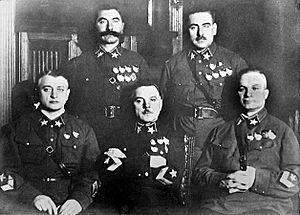
Tukhachevsky strongly criticized the Red Army's performance during military exercises in 1926. He felt that officers were not good at making decisions or communicating with their troops. He noted that officers lacked initiative and were slow to react.
Tukhachevsky became the first deputy defense minister under Kliment Voroshilov. Voroshilov did not like Tukhachevsky. Later, Voroshilov would be part of the Great Purge that affected Tukhachevsky. Many people believed Tukhachevsky, not Voroshilov, actually ran the ministry.
Stalin saw Tukhachevsky as a rival and called him Napoleonchik (little Napoleon). In 1930, some officers tried to say Tukhachevsky was plotting against the government. Stalin looked into these claims but found Tukhachevsky was "100% clean" at that time.
After this, Tukhachevsky wrote books about modern warfare. In 1931, Stalin agreed that the military needed to be more industrialized. Tukhachevsky was then given a main role in changing the army. He had new ideas about military strategy, especially using tanks and aircraft together.
Tukhachevsky was also interested in the arts. He became a friend of the composer Dmitri Shostakovich. They met in 1925 and played music together. In 1936, Shostakovich's music was criticized. Tukhachevsky spoke to Stalin to help his friend.
Theory of Deep Operation
Tukhachevsky is often given credit for the idea of "deep operation." This theory involves different parts of the army working together to attack far behind enemy lines. The goal is to destroy the enemy's supplies and organization.
This idea was not liked by everyone in the military at first. However, the Red Army largely adopted it in the mid-1930s. It was written into army rules in 1929 and further developed in 1935 and 1936.
An early example of how well deep operations could work was the Soviet victory over Japan at the Battle of Khalkhin Gol in 1939. Soviet forces under Georgy Zhukov defeated a large Japanese army.
Some people thought that the purges of army officers from 1937 to 1939 made "deep operations" less popular. However, they remained a key part of Soviet military plans. They were used very successfully during World War II, in battles like Battle of Stalingrad and Operation Bagration.
Fall and Death
On November 20, 1935, Tukhachevsky became a Marshal of the Soviet Union at age 42. In January 1936, he visited the United Kingdom, France, and Germany.
Just before his arrest, Tukhachevsky was removed from his job as assistant to Marshal Voroshilov. He was appointed military commander of the Volga Military District. Soon after he left for his new command, he was secretly arrested on May 22, 1937. He was brought back to Moscow in a prison van.
NKVD Chief Nikolai Yezhov watched over Tukhachevsky's questioning. Stalin told Yezhov that Tukhachevsky "should be forced to tell everything."
A few days later, Tukhachevsky confessed. He said he was a German agent and was working with others to take power. Tukhachevsky's confession still exists and has what looks like bloodstains on it.
On June 11, 1937, a special military court was held for Tukhachevsky and eight other generals. They were accused of treason. All of them were found guilty and sentenced to death. Stalin approved the verdict without even reading the records.
Within an hour, Tukhachevsky was taken from his cell. He was shot in the back of the head. Yezhov then told Stalin that Tukhachevsky had claimed to be loyal to the country and Stalin, and asked for mercy.
Aftermath
Tukhachevsky's family also suffered after his execution. His wife, Nina, and his two brothers were shot. Three of his sisters were sent to labor camps called the Gulag. His young daughter was arrested when she grew up and stayed in the Gulag until the 1950s. She was released later and died in 1982.
Before 1956, Tukhachevsky was officially called a traitor. But on January 31, 1957, Tukhachevsky and the others were declared innocent. They were "rehabilitated," meaning their names were cleared.
Many people believe Tukhachevsky's trial was unfair. The reasons for Stalin's actions are still debated. Some historians think that Nazi leaders created fake documents to make it look like Tukhachevsky was plotting against Stalin. These documents were then sent to the Soviet Union. The idea was to weaken the Soviet military.
Other historians believe that Stalin, Kaganovich, and Yezhov themselves made up Tukhachevsky's "treason." They might have used a double agent to spread false information to German intelligence. The Germans then improved on this false information and sent it back to the Soviets. This way, the Germans thought they were tricking Stalin into executing his best generals. But in reality, they were just helping the Soviet secret police.
Ironically, the fake German documents were never used in the trial. Instead, Soviet prosecutors used "confessions" that were forced out of the defendants.
Some also believe that Stalin wanted to remove Tukhachevsky and other high-ranking generals because he saw them as a threat to his power. Stalin and Yezhov later arrested and executed thousands of Soviet military officers.
Even though the Red Army still used a lot of cavalry when Tukhachevsky died, he had changed how the army thought. Many people, including Marshal Voroshilov, began to question the importance of cavalry. During World War II, the Red Army used combined units of cavalry and tanks. These units were very important in using the "deep operations" strategy.
Honours and Awards
- Imperial awards
- Order of St. Anne, 2nd class with swords, also awarded 3rd class with swords and bow; and 4th class with the inscription "For Courage"
- Order of St. Stanislaus, 2nd class with swords, also awarded 3rd class with swords and bow
- Order of St. Vladimir, 4th class with swords
- Soviet awards
- Order of Lenin (February 21, 1933)
- Order of the Red Banner (August 7, 1919)
- Honorary revolutionary weapon (December 17, 1919)
Images for kids
See also
 In Spanish: Mijaíl Tujachevski para niños
In Spanish: Mijaíl Tujachevski para niños


